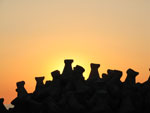According to the classics, the Hsia Emperor Yao instructed the Ho Hsi brothers to revise the calendar in 2405 BC.
This revised calendar is also known the as The Hsia calendar. It is quite similar to the western Gregorian calendar as it is also based on the earth’s orbit around the sun. However instead of starting the year on the 1st of January, the Chinese Solar calendar start the year on the 1st day of Spring which falls on or around the 4th Feb. The earth takes 365 and a quarter day to orbit the sun.
 Every quarter day makes one extra day and the western Gregorian calendar accounts for this extra day by inserting a day into Feb every 4 years. The Chinese Solar calendar takes account of this extra day by making adjustments to some of the years. This explains why the start of spring wobbles between the 3rd and 5th of February.
Every quarter day makes one extra day and the western Gregorian calendar accounts for this extra day by inserting a day into Feb every 4 years. The Chinese Solar calendar takes account of this extra day by making adjustments to some of the years. This explains why the start of spring wobbles between the 3rd and 5th of February.
In the Hsia Calendar, each year is divided into four seasons and 12 months. The naming convention is based on the Earthly Branches. The first month is Yin and this is followed by Mao, Chen and so on. Each month is further divided into two sub-months, the first known as Knot and the second half as Qi. This is illustrated in the table below.
| Hsia Calendar | |||
|---|---|---|---|
| Month | Branch | Knot & Qi | Western Dates |
| 1 | Yin | Start of Spring | February 4th/5th |
| Rain Water | February 19th/20th | ||
| 2 | Mao | Insects Awaken | March 6th/7th |
| Spring Equinox | March 21st/22nd | ||
| 3 | Chen | Clear Brightness | April 5th/6th |
| Grain Rice | April 20th/21th | ||
| 4 | Si | Start of Summer | May 6th/7th |
| Small Harvest | May 21st/22nd | ||
| 5 | Wu | Seed Planting | Jun 6th/7th |
| Summer Solstice | Jun 21st/22nd | ||
| 6 | Wei | Slight Heat | July 7th/8th |
| Great Heat | July 23rd/24th | ||
| 7 | Shen | Start of Autumn | August 8th/9th |
| Hidden Heat | August 24th/25th | ||
| 8 | Xu | White Dew | September 8th/9th |
| Autumn Equinox | September 23rd/24th | ||
| 9 | Hai | Cold Dew | October 8th/9th |
| Frost Descends | October 23rd/24th | ||
| 10 | Ji | Start of Winter | November 7th/8th |
| Slight Snow | November 22nd/23rd | ||
| 11 | Chou | Great Snow | December 7th/8th |
| Winter Solstice | December 22nd/23rd | ||
| 12 | Girl | Slight Cold | January 6th/7th |
| Great Cold | January 21st/22nd | ||
You may notice that the names of the Joint and Qi have an agricultural undertone. This is due to the fact the calendar was devised to regulate agriculture and it is also known as the Farmer’s Calendar.
You can use the online Ten Thousand Year Calendar to find the solar equivalent date for any western Gregorian day.


No comments:
Post a Comment